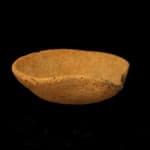Middle Bronze Age Terracotta Oil Lamp, 1900 BCE - 1600 BCE
Terracotta
3.75 x 1.25
SP.419
This ancient lamp might have burned in the Holy Land at during the time when the ancestors of the Israelites were still part of the Canaanite tribes that populated the...
This ancient lamp might have burned in the Holy Land at during the time when the ancestors of the Israelites were still part of the Canaanite tribes that populated the land that would become Israel. Judging by its open construction and vaguely pinched wick channel, this lamp derives from the Middle Bronze Age and is the ancestor of later designs that permeated the culture of the Middle East in Antiquity. Its simple, pinch pot construction is a tribute to the antiquity of the design, likely having Canaanite origins. Made of terra cotta, this simple item would have held olive oil and probably a wick of plant fibers or textile, allowing it to provide light for a few hours perhaps. This lamp of open-bowl design would later give way to more elaborate, enclosed lamps of the Hellenistic and Roman periods.
A metaphor for joy and prosperity, for hope, for life itself, lamps have illuminated the path of civilization for centuries. They have shed light on mundane and extraordinary events alike, guiding great thoughts through the night, and standing vigil with lonely passions. In the presence of this simple object, we are in touch directly with a vanished world, with the rooms and shrines once warmed by its glow, with the people who drew comfort from its light. Today it remains as an enduring symbol of man's desire to conquer the darkness.
A metaphor for joy and prosperity, for hope, for life itself, lamps have illuminated the path of civilization for centuries. They have shed light on mundane and extraordinary events alike, guiding great thoughts through the night, and standing vigil with lonely passions. In the presence of this simple object, we are in touch directly with a vanished world, with the rooms and shrines once warmed by its glow, with the people who drew comfort from its light. Today it remains as an enduring symbol of man's desire to conquer the darkness.



